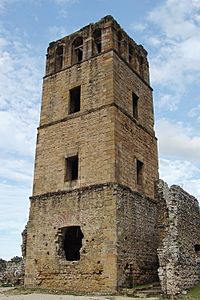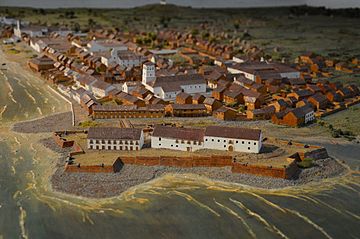Panamá Viejo facts for kids
Quick facts for kids Panamá Viejo |
|
|---|---|

Old Panama Cathedral
|
|
| Location | Panama City, Panama |
| Founded | 1519 |
| Official name: "Archaeological Site of Panamá Viejo", part of Archaeological Site of Panamá Viejo and Historic District of Panamá | |
| Type | Cultural |
| Criteria | II, IV, VI |
| Designated | 1117 (21st session) |
| Reference no. | 790-002 |
| Extension | 2003 |
| Region | Latin America and the Caribbean |
| Lua error in Module:Location_map at line 420: attempt to index field 'wikibase' (a nil value). | |
Panamá Viejo, which means "Old Panama" in English, is also known as Panamá la Vieja. It is what remains of the first Panama City, which used to be the capital of Panama. A Welsh privateer (a type of sailor who attacked ships for their country) named Henry Morgan destroyed the city in 1671. Today, Panamá Viejo is located near the modern capital. Since 1997, it has been a World Heritage Site, along with the historic district of today's Panama City.
Contents
History of Old Panama
Founding the City
A settlement was started on August 15, 1519. Pedro Arias Dávila and about 100 other people founded it. At that time, it was the very first lasting European town on the Pacific Ocean. It took the place of two older cities.
Becoming a Major Hub
Just two years later, in 1521, the settlement officially became a city. This happened because of a royal order from King Charles V of Spain. The city also received its own coat of arms. It quickly became a key starting point for trips to Peru. It was also an important place where gold and silver were sent to Spain.
Genoese Merchants in Panama
From the 1520s, some merchants from Genoa (a city in Italy) managed the trade and port of Old Panama. They did this for about 100 years. This was possible because the Spanish, who were allies with the Republic of Genoa, gave them special permission.
By 1587, there were 11 Italians in Panama who had become citizens. A census from around that time showed that Panama City had 548 residents. About 53 of these were foreigners, and 18 of them were Italians. Some were even descendants of the first Genoese settlers.
Challenges and Growth
The city faced several challenges. In 1539 and 1563, large fires destroyed parts of the city. However, these fires did not stop the city from growing. By 1610, the city had about 5,000 people. It also had 500 houses, along with convents, chapels, a hospital, and a large cathedral.
In the early 1600s, the city was attacked many times. Pirates and local indigenous people from Darién tried to raid it. On May 2, 1620, an earthquake damaged many buildings. Then, on February 21, 1644, a huge fire, known as the Great Fire, destroyed 83 religious buildings, including the cathedral. At this time, about 8,000 people lived in the city.
The Destruction of the City
By 1670, the city's population had grown to 10,000 people. On January 28, 1671, the Welsh privateer Henry Morgan attacked the city. He led 1,400 men who marched through the jungle from the Caribbean coast. Morgan's forces defeated the city's defenders. They then looted Panamá.
The city was completely destroyed by fire. It's not clear if Morgan and his army started the fire, or if the Captain General, Emanuel Gonzalez Revilla, ordered the gunpowder storage to explode. Either way, the fire destroyed the city. Thousands of lives were lost. Because of this, a new Panama City had to be built a few kilometers to the west. This new location is where the current Panama City stands today.
Henry Morgan was arrested after the attack. However, he was later set free and even rewarded. This was because he proved he didn't know about the Treaty of Madrid. This treaty had just been signed and ended fighting between England and Spain.
World Heritage Recognition
In 1997, UNESCO added Panamá Viejo to its World Heritage list. They explained that the site is important because it is the "oldest continuously occupied European settlement on the Pacific coast of the Americas."
Panamá Viejo in Popular Culture
This special UNESCO World Heritage Site has been featured on popular TV shows.
- It was a "Pit Stop" location for the 19th season of The Amazing Race. This is a reality TV show where teams race around the world.
- The reward feast from a challenge in the 7th season of the CBS show Survivor was held at this historic place.
Gallery
See also
 In Spanish: Panamá Viejo para niños
In Spanish: Panamá Viejo para niños







